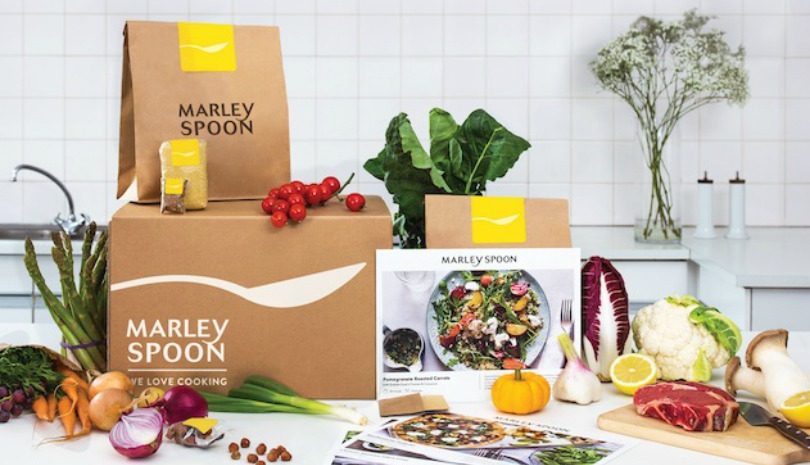Can meal kit companies handle the heat?

Meal kit companies aim to make dinner-time easier by delivering pre-portioned ingredients and recipes to customers’ doorsteps on a weekly basis.
No more mad rush to the supermarket after work, no more extra produce left to wilt at the back of the fridge, no more spaghetti Bolognese for the third night in a row.
At least, that’s the promise. Solving the daily dinner dilemma has proved a hard nut to crack, with many businesses reporting high marketing costs and low customer retention.
It’s about to get even harder. Recent trademark activity from Amazon suggests the e-commerce giant intends to sell meal kits, following its acquisition of Whole Foods last month.
Once thought of as the future of food shopping, meal kits are in a state of flux, as the changing fortunes of US-based meal kit leader Blue Apron show.
Valued at US$2.2 billion in its latest round of private fundraising two years ago, Blue Apron ultimately listed on 29 June with a market cap of US$1.9 billion, after Amazon’s surprise grocery move.
At the time of this writing, Blue Apron’s stock was trading around 36 per cent down from its debut price of US$10, at about US$6.40 a share.
In a document filed ahead of its IPO, Blue Apron revealed that despite heavy investment in marketing, customer retention remains a problem, an equation that simply doesn’t add up to long-term profitability.
Major Australian meal kit companies are watching the Blue Apron developments with interest, according to conversations Internet Retailing had with Marley Spoon and Aussie Farmers Direct.
It remains to be seen whether Blue Apron is the canary in the kitchen, or will provide a roadmap for growth.
What’s driving the meal kit industry?
The popularity of meal kits in Western markets like the US, Europe and Australia can be attributed primarily to the convenience they offer consumers, according to Josh Sigel, chief operating officer of Innit, a US-based tech startup that describes itself as the operating system for the kitchen.
“A lot of consumers today are hung up on decision fatigue. They don’t want to think about answering the question of what’s for dinner. Meal kits reduce the complexity and stress of the decision-making process,” says Sigel, adding that many people don’t have time to go to the supermarket.
Even when they do, the way they buy groceries is different than in previous decades, says Gary Mortimer, a professor at QUT’s business school.
“Consumers have shifted away from the way they’ve traditionally bought groceries, which was doing a big shop once a week. They’re shopping more frequently and buying smaller basket sizes each time.
“Even structurally, the size of kitchens and prep areas in smaller apartments don’t facilitate a large grocery shop,” he says.
But if meal kits are such a convenient alternative for today’s time-poor consumers, why have companies in the space struggled to retain customers?
According to Sigel, customer retention for some meal kit companies in the US is in the low single digits, despite heavy marketing spend and free trials for new users.
Blue Apron alone spent US$144 million in 2016 and US$60.6 million in the first quarter of 2017 on marketing, including heavy discounts for first-time users, direct mail and television and podcast ads.
But both its average number of orders per customer and the amount spent per order have declined over the last year.
Rolf Weber, co-founder of Marley Spoon, a Germany-based meal kit company that entered Australia in 2015, acknowledged that customer acquisition cost is a key factor in profitability, but he says he’s not concerned about Blue Apron’s data.
“Of course, I’ve seen the curves around customer retention for Blue Apron and HelloFresh, but it only tells part of the story, not the whole story,” Weber says.
“We’re very happy with where we are and have a good return on marketing spend.”
Indeed, Marley Spoon has recently ramped up its marketing efforts beyond online channels to include television ads and letterbox drops, as well as referrals.
“We’ve had quite strong growth on back of that. We also have a referral system, where you have a chance to send a free box to friends and family,” he says.
Expanding and personalising
Aussie Farmers Direct has also expanded its offering since it first entered the meal kit space with a Weight Watchers collaboration 12 months ago.
The online grocery company now offers 12 different meal kit options for couples and families, depending on the number of meals they want to receive each week.
“Meal boxes are now 20 per cent of our overall revenue,” says Julia Hunter, a spokesperson for Aussie Farmers Direct, which launched a television campaign promoting the products in February.
Hunter says the company is well-positioned to take on new challengers in the meal kit space – whether that’s Amazon or local supermarkets.
“We’re in a nice sweet spot,” she says, explaining that the company will be able to offer more personalised meal kits in future, thanks to its broader range of dairy, produce, meat and dry goods.
“If you’re a pureplay meal kit, which we’re not, personalisation would be harder. But because we’re carrying the range [of groceries and fresh produce] anyway, it’s more achievable. If you get a meal box with us, you can also get milk and eggs and avoid going to the supermarket entirely,” she says.
Ultimately, that’s where Innit’s Sigel believes the market is heading.
“I think we’ll begin to see the meal kit industry move away from fixed meals and toward more customised options,” he says.
“The ultimate winner will be the company that can figure out how to fulfil groceries at the meal level, where consumers order meals [from a range of options] and get all groceries for those meals,” he said.
Comment Manually
You must be logged in to post a comment.

Comments
Paul Warren
YouFoodz are leading the way in this space.
I’m a customer and can’t rate them highly enough.